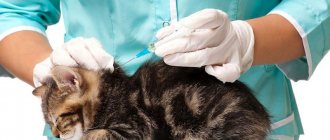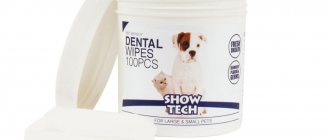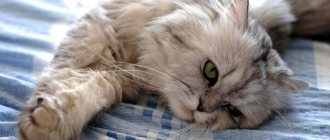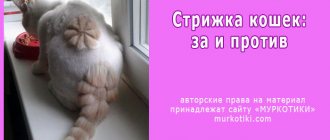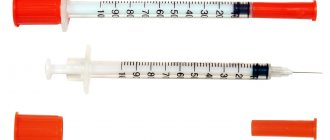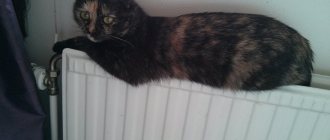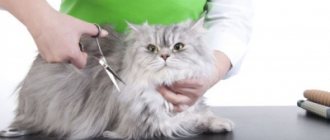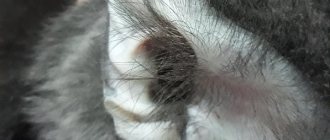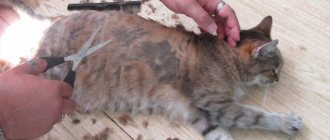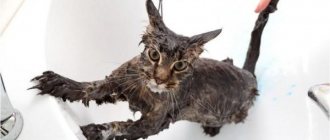Many owners tend to think that caring for a cat's teeth is unnecessary. And they don’t suspect that dental problems occur in cats no less often than in people. Caries is rare in cats, but tartar is a serious problem for many. The owner must know how to brush a cat’s teeth and how to teach him to do it. Regular cat oral hygiene not only protects against the formation of lime deposits, but also significantly reduces the risk of developing serious dental problems: gingivitis, stomatitis, periodontitis.
Why is it necessary to brush your cat's teeth?
The condition of a cat's teeth largely depends on nutrition.
If the cat is outdoor, hunts and actively uses its fangs, or the basis of its diet is dry food, minced meat, plaque will not form on the enamel. If the animal eats mainly soft food (pates, canned food, minced meat), friction does not occur. Over time, plaque accumulates on your cat's teeth. It is formed from food debris, salts contained in saliva, and bacteria that form a dense film. First, the stone is deposited along the edge of the gum. This threatens the occurrence of gingivitis in the cat. If left untreated, the stone will grow and become larger than the tooth. Inflammation intensifies. The gums separate from the teeth and bacteria gain access to the roots. The cat begins to drool, and there is an unpleasant odor from the cat’s mouth. In advanced cases, teeth become loose and hurt. The cat becomes painful when chewing food.
Periodontal damage, in turn, leads to the development of gastritis, inflammation of the duodenum, and the presence of microbes provokes dysbacteriosis.
And if the plaque is easy to remove at home, then you can only get rid of the stone in a veterinary clinic. Therefore, the owner’s task is to prevent plaque from accumulating beyond a critical level.
DO CATS' TEETH BE BRUSHED IF THEIR TEETH ARE IN PERFECT CONDITION?
I would like to note that some cats may not need to brush their teeth at all; many live up to 15 years with perfect teeth, but for some this procedure may be prescribed by veterinarians.
If the doctor does not oblige you to this procedure, it is up to you to decide whether your cat’s teeth need to be brushed. This procedure can be carried out for prevention.
How to brush a cat's teeth
How to train a cat to brush its teeth
Getting used to brushing your teeth can take from a couple of days to several weeks.
- They start by moistening their finger in meat or fish broth (depending on the pet’s preferences) and running it over the teeth, 1-2 times, no more. Everything needs to be done when the cat is in the right mood.
- After several procedures, soak gauze wrapped around your finger in the broth and try to massage your gums.
- The next step is with the paste. Squeeze small peas of meat/fish flavored paste onto your finger and give to the animal.
- You can try brushing your cat's teeth with a brush. Squeeze the paste onto the bristles and let the cat lick it off. If you have doubts about whether you should use a brush, for fear of hurting your pet, you can do everything with your finger wrapped in a bandage. In addition, it is better to avoid brushing if your cat has sensitive gums.
- Cleaning is carried out once every 1-2 weeks. After the cat gets used to it - 1-2 times a week. However, some pets with a tendency to develop plaque require daily brushing. Thus, a genetic predisposition to dental diseases can be traced in Persians, British, Scottish and Siamese cats.
Each cat's body is individual, so how often you need to brush your teeth is also individual. Dentists recommend performing the procedure 2 times a week.
What should you do if your cat actively resists brushing her teeth?
Some animals are extremely intolerant of such a procedure; in this case, there is no need to torment either yourself or your pet. It’s worth trying other methods to help clean your pet’s mouth at home:
- It is necessary to replace soft food with solid food from time to time, this will reduce the likelihood of dental plaque.
- Veterinary pharmacies sell special toys that do a good job of cleaning the surface of your pet’s teeth.
- If the cat is tolerant of the paste, then it can be added to dry food or dental toys. This way it will enter the pet’s oral cavity.
- Liquid pastes have now been developed that can control the amount of bacteria in a cat's mouth. Liquid paste is added to your pet's water. You must first dilute it in water (1 teaspoon of solution per glass of water). However, you should not use it frequently, because it can cause changes in tooth enamel.
- If your cat eats natural food, then you can buy him treats that contain nutritional fiber. These fibers clean the pet's mouth while chewing.
- You can wipe your pet's teeth with a solution of baking soda or hydrogen peroxide.
Brushing your teeth at home should not completely replace annual checkups with your veterinarian.
Brushing your teeth is an extremely unpleasant procedure; if you approach it with caution, starting from a young kitten, the pet will quickly adapt to this event.
What you need for proper cleaning
The basic hygiene kit is a brush and toothpaste for cats. Human powders and pastes are toxic to animals and should not be used.
Types of toothbrushes for cats
A toothbrush for cats should be chosen with soft bristles, so the gums are less damaged. You can use a brush just like for people, just a smaller size.
The second option is finger brushes. They are made in the form of a cap that fits on the finger. Fingertips are available in 2 types: with bristles for cleaning and with pimples for massaging the gums. Usually sold as a set.
An alternative to a toothbrush for cats is gauze or a piece of bandage. The fabric is wrapped around the finger and the teeth are treated.
Toothpastes and gels
For oral hygiene, products are available in different forms:
- Classic toothpaste for cats.
Typically produced either with flavoring (chicken, beef) or unflavored. The product does not foam and can be swallowed. How much paste to add is indicated in each manufacturer's instructions.
- Liquid toothpaste for cats.
This is an option if mechanical cleaning cannot be carried out due to the cat’s “protest”. The product is dissolved in water that the pet drinks.
- Dental gels.
They are usually produced without flavoring additives. The product is applied in a small amount (no more than 3-5 drops) to the gums or mucous membranes. This can be done with a special dispenser, a cotton swab or your finger. The cat begins to lick itself, more saliva is released, which mixes with the gel. The resulting liquid softens plaque, cleanses the mouth of food residues, and removes unpleasant odor. Tooth gel for cats is produced by the following manufacturers:
- Beaphar;
- Clini;
- TropiClean;
- Api-San (Zubastic gel).
If there are stone deposits, then after gels, brushing is necessary, since the stone softens, but does not dissolve, and it must be cleaned off.
Preparation for the procedure
It is advisable to accustom your cat to brushing his teeth at an early age. You need to devote time to this from the day you take the kitten home. You can also train an adult cat, which previously cleaned its teeth only with rough food. In order to do this, you will need to perform several steps :
- Buy a specialized toothpaste and brush. Toothbrushes intended for humans are not suitable for cats, as their bristles are too hard and can damage the gums. Paste intended for humans is also not suitable for cats - a large amount of fluoride has a negative effect on tooth enamel;
- So that the cat is not afraid of brushes and toothpaste, you need to let him “get to know” these things. The cat must sniff and examine them. This way he won’t be afraid of them during subsequent cleaning. It is also recommended to let the cat get used to the taste of the new toothpaste - he should try it before brushing his teeth;
- Brushing your teeth at home requires a calm environment. Choose the quietest period of time when the cat is not playing, is not hungry and does not want to sleep. Gently pick up the cat and pet it, showing him the brush and toothpaste. When a cat is calm, he will not resist.
Once the preparation for brushing has been completed, you can begin brushing your teeth. If several cats live at home at once, then they need to brush their teeth with different brushes, just like people. Cats can also contract oral diseases from each other through toothbrushing through saliva.
How to brush your cat's teeth at home
Almost all cats are not enthusiastic about the procedure of brushing their teeth and will resist. It is difficult to immediately find the right position for your pet.
Experienced cat breeders recommend the following technique:
- Place the cat with its back to you.
- To make the animal raise its head, gently stroke its neck.
- With your left hand, grab your head from above.
- Use your thumb to first expose the right upper jaw and brush as much as possible, the cat will not sit still.
- Before brushing the teeth on the other side, you need to give the animal a rest, praise it, and calm it down. Spend 30-60 seconds on each side.
- Then move on to the lower jaw. In this case, it is more convenient to move the lip away with your index finger.
Features of teeth cleaning products
The pharmacy sells special toothbrushes that help the owner brush the cat’s teeth . Eg. Pharmacies sell special brushes for cats, which are smaller in size than human ones and have softer bristles. You can also buy a brush in the form of a transparent finger attachment or a stick for cleaning cats' teeth.
It will be much more convenient for a person to brush their teeth like this, but your pet should get used to it if you previously used a standard brush. The disadvantage of the nozzle is that the cat can easily bite through it if it gets scared. Toothpaste for cats differs from human toothpaste in its composition, as well as taste - pastes are sold with the smell of fish, poultry and meat. Toothpastes in different flavors are great for kittens, but be careful not to let your pet eat the toothpaste.
© shutterstock
If you want to try a more modern method, then ultrasonic teeth cleaning for cats will help you. The procedure will rid the animal of tartar and restore the natural color of the teeth without any harm to health.
Alternative Dental Care Products
Cleaning your cat's teeth with a brush and paste is not a task that every cat breeder can do. In difficult situations, there are alternatives in the form of tablets, sprays and treats.
Pills
Dental discs Stomadex C 100 can be used to prevent tartar. The disc is glued to the inner surface of the cheek (closer to the toothless edge) or under the upper lip. First you need to dry the mucous membrane with a napkin and then press the tablet with your finger.
The drug is used in courses of 10 days and 1 tablet per day. The disc stays on the mucous membrane for a long time, so substances constantly reach the treated surface. It is recommended to carry out the procedure after the last feeding, before bedtime.
Sprays
An alternative to mechanical cleaning is the use of a spray. The method is suitable for aggressive and disobedient animals. But it works more as a means of prevention. Just spray the liquid and it starts working. There is no need to brush your cat's teeth.
Napkins
Manufacturers of veterinary products produce wet cleaning wipes with special impregnation, for example, Show Tech Products, Taurus.
You need to wrap your finger with a napkin and wipe the cat’s teeth. This remedy helps only at the initial stage, until the plaque hardens. However, if the cat is not accustomed to the procedure, it will be difficult to put a napkin in its mouth.
Powders
As a prophylactic agent, powders are used that are added to animal feed, for example, ProDen PlaqueOff. The drug reduces plaque, has a whitening effect, destroys bacteria, and freshens breath.
Treats
In the range of products for the prevention of plaque and tartar, treats for cleaning teeth occupy their niche.
Cleaning plaque and tartar in a veterinary clinic
Cats' teeth are cleaned at a veterinary clinic when it is not possible to do it yourself. Or if, despite regular home treatments, plaque and tartar do not disappear after them, and the gums become inflamed and begin to bleed. The cat stops feeding 12 hours before and stops drinking 1 hour before. Before treatment, the mouth is examined with a probe to identify intragingival pockets.
Ultrasound cleaning of a cat's teeth does not require anesthesia. But if you need to remove tartar, the operation is performed under anesthesia. The cat should be in a relaxed state, lying still, as its mouth will be open for a long time.
Without anesthesia, water can enter the trachea and there is a high risk of injury. The light drug Propofol is used for anesthesia. Elderly pets are calmed with Feliway pheromones; they may not be able to withstand anesthesia.
In a veterinary clinic, a cat’s teeth are cleaned using two methods:
- ultrasonic scaler (from 2000 rub.);
- a special device with a supply of chilled water (from 2000 rubles).
Both methods are painless, help clean even hard-to-reach places, and do not cause side effects. After cleaning, the enamel is polished. All veterinary procedures last 20-30 minutes.
Using home remedies for cleaning
Ideally, oral hygiene involves the use of special products designed for pets. But they are not always at hand.
At home, the procedure can be carried out using wine and soda. These products help remove food debris and stone formation.
First, the teeth are moistened with wine, then soda is applied. The components react with each other and purification occurs.
Necessary tools, materials
When choosing equipment, you need to take into account the pet's temperament. If the cat is calm and trusts its owner, then it will be possible to do without a brush. If the animal is aggressive and doesn’t like having fingers put in its mouth, you will have to choose non-contact hygiene products.
The first thing you need to do is choose a toothbrush.
There are two types of tools:
- fingertip;
- with a handle.
The fingertip makes it possible to completely control the cleaning process, but the pet can bite the owner. A brush equipped with a handle is considered safe.
It must be used carefully so as not to damage the animal’s gums.
A toothbrush that is intended for humans cannot be used for a cat, because the bristles on it are much stiffer and can scratch the delicate mucous membranes. As a last resort, you can use a baby brush . Its head is small and the bristles are much softer.
Cleaning is carried out with a special paste or simple tooth powder. The main thing is that the product does not have a strong smell or taste, otherwise the animal will not accept the procedure (cats do not like the smell of mint.
Cat hygiene products have a meat or fish aroma.
